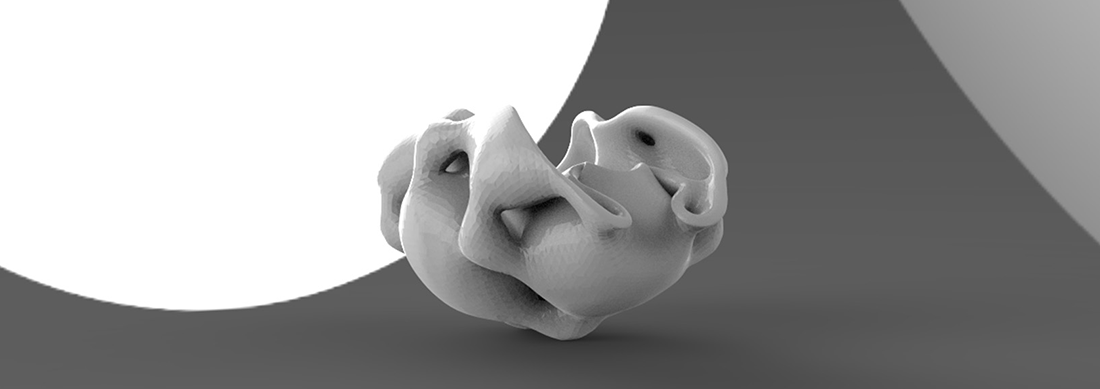Jonathon Anderson + Ming Tang
 Jonathon Anderson + Ming Tang, Computational Shell
Jonathon Anderson + Ming Tang, Computational Shell
Statement
The influence of digital media and information technology is increasingly evident within the creative careers. Recently, this multidisciplinary approach has reconditioned the design/making process by establishing new methods of form finding and fabrication.
This project combines the notion of “mathematic” with the notion of “morphology”. For us Computational Shell represents a process that is experimental in nature and explores volumes, surfaces, and vertices that are far to complex to generate using traditional methods. In this project a series of computer models were manipulated and deformed by a series of operations and Booleans. This digital model represents the beauty in rhythm, strict proportions, movement, and repetition found in seashells.
Today, robust digital process results in novel forms that not only explore the marriage between mathematics and sculpture but also provides a platform for digital computing and physical realization.
Download Anderson_Tang.stl
![]()
Biography, Jonathon R. Anderson
Jonathon R. Anderson is an Assistant Professor of Architecture at the University of Nevada Las Vegas. He holds a Master of Fine Arts in Furniture Design from Savannah College of Art & Design and a Bachelor of Science with concentration in Architecture from Southern Illinois University. Additionally, Jonathon’s consulting and professional practices concentrate on the use of digital design for fabrication.
Jonathon’s work has been published, retailed, and exhibited at an international level, and explores how industrial manufacturing and CNC technologies influence the design and making processes. His studio work is characterized by innovative and explorative methods that result in interconnected design, fine art, and technology solutions. From this non-traditional process emerges a provocative, complex design language that visually communicates at varied scales and emphasizes corporeal and phenomenological experiences. To Jonathon, making is not only a practice but a form of critical thinking.
He is a founding partner of MADcubic, a research and speculative architecture firm that has been awarded in several international competitions including eVolo skyscraper competition, YAF 10up design/build competition, d3 Natural Systems, and the AIA Austin TOGs competition. Jonathon is also a principal and founder of the international design firm sur:face studio, which has offices in Greensboro, NC and Hangzhou, China. Jonathon is currently a co-editor of the International Journal of Interior Architecture and Spatial Design (ii journal).
website: www.jonathonanderson.com
Biography, Ming Tang
Ming Tang, LEED AP, is the Assistant Professor at School of Architecture and Interior Design, University of Cincinnati. He is the founding partner of Tang & Yang Architects, which has won numerous design awards in China, Spain, Mexico, U.K. and United States, including, the first prize of d3 Natural System, the first place of Cities with Soul, the first place of IAAC self-sufficient housing contest, the first place of Chichen Itza lodge museum design.
Before he taught at the University of Cincinnati, he led the Electronic Design program ( Digital Design + Computation) at the Savannah College of Art and Design and was a professor in the Architecture Department. He has worked with Michigan State University’s M.I.N.D Lab, University of Southern California’s Institute for Creative Technologies, and China Architecture Design & Research Group. He holds Master of Architecture Degree from Tsinghua University, Maser of Art Degree in Digital Media and Technology from Michigan State University, and Maser of Final Art degree in Interactive and Game Design from Savannah College of Art and Design. His multi-disciplinary research includes parametric design, digital fabrication, building information modeling, performance driven design, digital computation,virtual reality, algorithm & programming, GIS, simulation, mathematical form, interactive design and visual effects. His research has beenpublished in various international conferences, journals, books and exhibitions. He is the author of the book, urban paleontology, evolution of urban forms. His forthcoming book, Parametric Building Design with Autodesk Maya, will be published by Rougtledge in 2014.
website: www.ming3d.com
